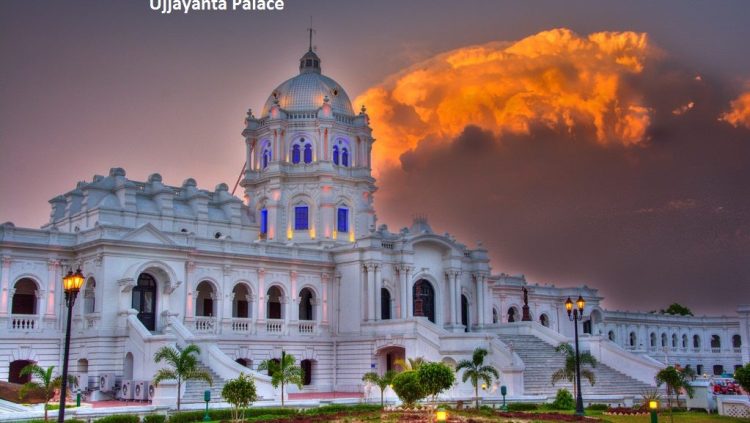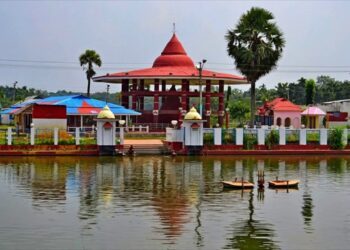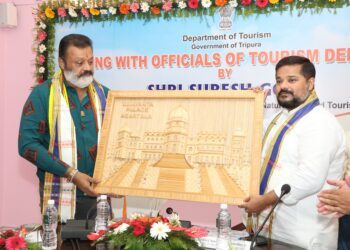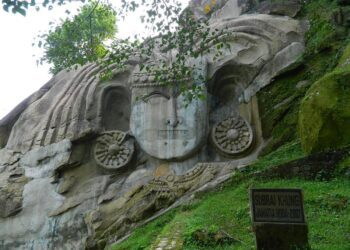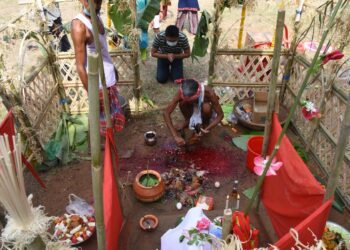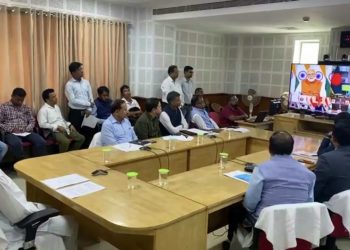The Ujjayanta Palace, also known as Nuyungma, is a historic palace located in the capital city of Agartala, Tripura. The palace was built in 1901 by Maharaja Radha Kishore Manikya of the Tripura kingdom and was named by Rabindranath Tagore. The palace served as the residence of the ruling Manikya dynasty until Tripura’s merger into India in 1949. Today, the palace is known as the State Museum of Tripura and serves as a popular tourist destination.
The construction of the palace began in 1899 and took two years to complete. It is situated on the banks of two lakes and is surrounded by beautiful gardens inspired by European style. The palace is an excellent example of neo-classical architecture and features a unique blend of Hindu and Muslim architectural styles. The palace has three floors and is spread across an area of 28 acres.
The Ujjayanta Palace was purchased from the royal family by the Government of Tripura in 1972-73 for Rs. 2.5 million. From 1972 until July 2011, the palace served as the State Legislative Assembly building. It was during this time that several renovations and additions were made to the palace, including a new annexe building.
After the State Legislative Assembly moved to a new location, the Ujjayanta Palace was converted into a State Museum. The museum showcases the lifestyle, arts, culture, tradition, and utility crafts of communities residing in northeast India. The museum’s collection includes a vast array of stone sculptures, coinage of the Manikya dynasty, and other artifacts that provide a glimpse into the rich cultural heritage of the region.
The museum is spread across three floors and features several galleries that house different exhibits. The ground floor of the museum is dedicated to the lifestyle and culture of the indigenous tribes of Tripura. The first floor features a collection of ancient coins, sculptures, and other artifacts from the region. The second floor of the museum houses a collection of paintings and artworks, including the works of Rabindranath Tagore and other renowned artists.
The Ujjayanta Palace has been restored and renovated several times over the years, most notably in the 1990s. Today, the palace and museum are open to the public, and visitors can explore the beautiful gardens and architectural marvels of the palace while also learning about the rich cultural heritage of Tripura and northeast India.
In conclusion, the Ujjayanta Palace is a historic landmark and a testament to the rich cultural heritage of Tripura and northeast India. The palace’s unique architecture and stunning gardens make it a popular tourist destination, and the museum’s collection of artifacts provides an excellent opportunity for visitors to learn about the region’s rich history and culture.
Tripura is a state in northeastern India that is well-connected by road, rail, and air. The Ujjayanta Palace, located in the capital city of Agartala, is easily accessible by train and bus.
By Train:
Agartala Railway Station is the nearest railway station to the Ujjayanta Palace, which is located about 4 kilometers away from the palace. The railway station is well-connected to major cities across India, including Kolkata, Guwahati, and Delhi. Visitors can take a taxi or an auto-rickshaw from the railway station to reach the palace.
By Bus:
The Ujjayanta Palace is located in the heart of Agartala city and is easily accessible by bus. The Agartala Bus Terminal, located about 3 kilometers away from the palace, is the main bus station in the city. Visitors can take a bus from nearby cities like Guwahati, Silchar, and Shillong to reach Agartala. From the bus terminal, visitors can take a taxi, auto-rickshaw or bus to reach the palace.
By Air:
The nearest airport to Agartala is the Agartala Airport, located about 12 kilometers away from the palace. The airport is well-connected to major cities across India, including Kolkata, Delhi, and Guwahati. Visitors can take a taxi or an auto-rickshaw from the airport to reach the palace.
Local Transportation:
Visitors can also use local transportation such as auto-rickshaws, taxis, and buses to travel within the city. These modes of transportation are easily available and relatively affordable.
In conclusion, visitors can reach the Ujjayanta Palace by train, bus, or air. The nearest railway station and airport are well-connected to major cities across India, while the bus terminal in Agartala offers bus services to nearby cities. Visitors can use local transportation to travel within the city and explore the palace and its surrounding areas.


